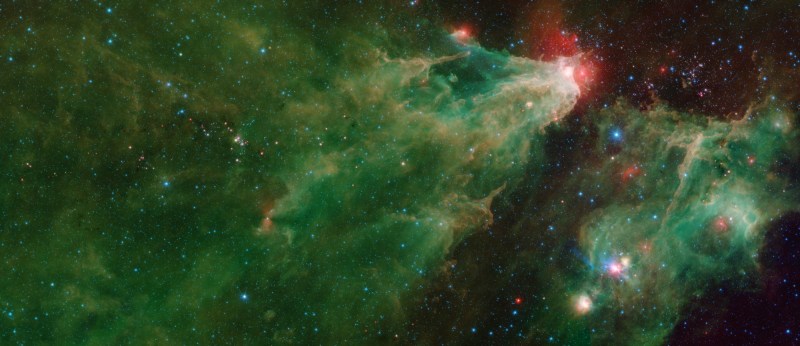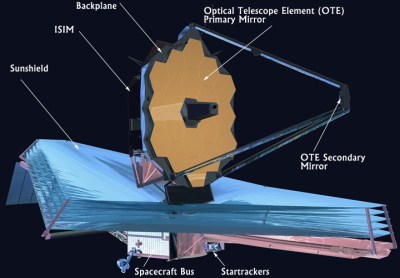Today, after 16 years of exemplary service, NASA will officially deactivate the Spitzer Space Telescope. Operating for over a decade beyond its designed service lifetime, the infrared observatory worked in tandem with the Hubble Space Telescope to reveal previously hidden details of known cosmic objects and helped expand our understanding of the universe. In later years, despite never being designed for the task, it became an invaluable tool in the study of planets outside our own solar system.
While there’s been no cataclysmic failure aboard the spacecraft, currently more than 260 million kilometers away from Earth, the years have certainly taken their toll on Spitzer. The craft’s various technical issues, combined with its ever-increasing distance, has made its continued operation cumbersome. Rather than running it to the point of outright failure, ground controllers have decided to quit while they still have the option to command the vehicle to go into hibernation mode. At its distance from the Earth there’s no danger of it becoming “space junk” in the traditional sense, but a rogue spacecraft transmitting randomly in deep space could become a nuisance for future observations.
From mapping weather patterns on a planet 190 light-years away in the constellation Ursa Major to providing the first images of Saturn’s largest ring, it’s difficult to overstate the breadth of Spitzer’s discoveries. But these accomplishments are all the more impressive when you consider the mission’s storied history, from its tumultuous conception to the unique technical challenges of long-duration spaceflight.
A Scope for the Shuttle
While the Spitzer Space Telescope might have been launched in 2003, its origins date back to the Apollo era. As NASA’s ability to launch large payloads into space improved, astronomers began to consider the possibility of an orbiting infrared observatory. An IR telescope in space would vastly outperform a similarly sized telescope on Earth due to the fact that most of the infrared radiation from space is absorbed by water vapor and carbon dioxide in the atmosphere. While it would be a considerable technical challenge to build, launch, and operate such a telescope, there was no question it would be able to do more useful science than anything that could be built on the ground.

In 1976, Hughes Aircraft Corporation released their preliminary design study for the Shuttle Infrared Telescope Facility (SIRTF), a cryogenically cooled IR telescope that would be mounted inside the cargo bay of the Space Shuttle. Thanks to the promised rapid reusability of the Shuttle, the SIRFT could be regularly upgraded and reflown to take advantage of improvements in IR imaging technology.
Unfortunately, the reality of the Space Shuttle program turned out to be very different than what was originally envisioned. Rather than launching regularly and cheaply like a commercial airliner, the Shuttle ended up being just as slow and expensive a ride into space as more traditional rockets. To make matters worse, experiments performed during the STS-51-F mission showed that IR observations made from the Shuttle were complicated by the aura of dust and heat that surrounded the winged orbiter.
By the mid-80s, it became clear SIRTF wasn’t going to work as a part of the Shuttle. It would need to be a free-flying instrument, which naturally made the design considerably more complex. SIRTF would not only have to fit onto a smaller rocket, but it would also need to have its own means of communication, propulsion, navigation, and power generation.
Beating the Heat
Throughout the 1990s, the SIRTF concept went through several revisions. Now called Space Infrared Telescope Facility to differentiate itself from the earlier Shuttle-centric design, the new telescope needed to be small and light enough to be carried on a Delta II rocket. Optimizing a design for spaceflight is never easy, but in the case of the SIRTF, it posed some unique challenges.
For optimal performance, the IR sensors would need to be cooled down to near absolute zero. This means a cryogenic coolant and insulation, which adds mass and bulk to the spacecraft. The easiest way to reduce launch mass would be to load less coolant onboard, but that reduces the useful life of the telescope: an exceptionally difficult compromise to make.
To solve the problem, a radical change was made to the original concept. Rather than operating in low Earth orbit like the Hubble Space Telescope, SIRTF would be launched into deep space. At that distance, the cooling system would no longer have to contend with the heat radiating from the Earth. Naturally the spacecraft would be heated by the sun as well, but that could be mitigated with a passive solar shield. SIRTF would still need to bring along liquid helium to cool the sensors, but in deep space it would require far less.
With these changes to the mission parameters, it was estimated that the SIRTF could keep its instruments cooled to approximately 5 Kelvin ( -268 °C, -450 °F) for up to 5 years.
Spitzer’s Evolving Mission
The SIRTF was launched aboard a Delta II rocket on August 25th, 2003. As was customary at the time, NASA didn’t officially change the spacecraft’s name to the Spitzer Space Telescope until it was ready to begin observations. It was named after Dr. Lyman Spitzer, an early proponent of space telescopes who helped lobby Congress for the funding necessary to build the Hubble before his death in 1997.
From December 2003 to May 2009, Spitzer observed the energy from distant galaxies, young forming stars, and exoplanets at wavelengths between 3.6 μm and 160 μm. After that point the liquid helium ran out, and the temperature of the instrumentation rose to approximately 30 K (−243 °C, −406 °F). This limited the telescope’s observations to a minimum wavelength of 4.5 μm, and marked the beginning what mission controllers referred to as the “Spitzer Warm Mission”.

By the time the so-called warm phase of the mission started, Spitzer was already years beyond its original design lifetime. But the discoveries it made during this period, either on its own or when working in conjunction with other instruments and observatories, were no less impressive. Data from Spitzer helped identify a galaxy that lies an incredible 32 billion light-years from Earth, and techniques such as transit photometry and gravitational microlensing enabled it to perform exoplanet research which had never even been considered in its original mission.
Scientific observations have continued to the present day, though in recent years, declining battery health and the ever-increasing distance between Spitzer and Earth has made downloading the resulting data more difficult.
The Future of Infrared Astronomy
The Spitzer Space Telescope has already outlived the European Space Agency’s similar William Herschel Telescope, and NASA’s Wide-field Infrared Survey Explorer (WISE) isn’t sensitive enough to perform the same sort of observations. Naturally there’s plenty of data to sift through for the time being, but after today, how long will astronomers have to wait before new IR observations can be made?

Spitzer’s direct successor, known as SAFIR (Single Aperture Far InfraRed), is at this point just a concept with no firm timeframe for its construction or launch. The European Space Agency is looking to launch Euclid in 2022, though it will only be able to look as far into the infrared wavelengths as Spitzer. NASA also continues to operate Stratospheric Observatory For Infrared Astronomy (SOFIA), a modified Boeing 747 that flies high enough to avoid the majority of the IR-blocking water vapor in the atmosphere.
But certainly the most exciting prospect on the horizon is the James Webb Space Telescope (JWST). Slated to be launched next year, the JWST won’t be able to see all of the same IR wavelengths that Spitzer did during its cold phase, but the telescope’s incredibly large 6.5 meter diameter mirror will allow it to observe objects that are dimmer and farther away than ever before.
https://news.google.com/__i/rss/rd/articles/CBMiWGh0dHBzOi8vaGFja2FkYXkuY29tLzIwMjAvMDEvMzAvdGhlLXNwaXR6ZXItc3BhY2UtdGVsZXNjb3BlLWVuZHMtaXRzLWluY3JlZGlibGUtam91cm5leS_SAQA?oc=5
2020-01-30 15:00:00Z
52780578899672
Tidak ada komentar:
Posting Komentar